Among the various issues that can afflict plumbing fixtures, unfortunately, leaking is one of the most significant and troublesome problems. Even if you want heroically stopping the water, you’ll find it impossible to prevent water from escaping a leaky pipe completely. However, there are various methods to fix leaking water valves, which depend on the cause of the fault. We’ll explore these solutions in detail below.

Types of Water Valves
Before we delve into solutions for fixing leaks, let’s review the different types of industrial water valves. Generally, there are two main types: traditional screw-type and lever-type valves.
Long Handle Lever Valve (Lever-type)
These valves, such as the 1/2 long handle single-stroke valve, are cost-effective and provide high water recovery. They also have high durability and low maintenance costs.
Single Head Gland Valve (Lever and Screw-type)
Typically used for managing boiler water, the long handle single-stroke non-gas gland valve 3/4 has a nut on one side and threads on the other.
Double Head Gland Valve (Lever and Screw-type)
Double gland valves like the 3/4 double gland nut valve have glands on both ends for connecting to a wide range of plumbing fixtures.
Coupling Valve (Screw-type)
Small coupling valves, such as the 1/2*Ø20 single gland coupling valve, are used for separating branches.
Butterfly Handle Valve (Screw-type)
Valves like the 1 butterfly handle package valve are used for installing and operating various package systems, with a very low risk of handle breakage.
Gland Nut Valve (Screw-type)
The 1 single gland nut valve is an industrial valve used to control the flow of fluids.
Radiator Valve (Screw-type)
Radiator valves are available in both pair (top and bottom) and top-only models, allowing buyers to choose according to their needs.

Prevention is Better Than Cure
As the saying goes, prevention is better than cure. One of the most important ways to prevent water valve leaks is to choose the right valve according to the working pressure and the intended environment. Therefore, in terms of repair and maintenance of valves, periodic inspections and adherence to work standards are crucial.
Exploring Solutions for Fixing Water Valve Leaks
Given the decreasing water reserves in Iran and the global concerns about the future, few are indifferent to leaking water valves, even if the valves are not in their own homes. Additionally, increased water bills also make indifference to water leaks untenable.
Checking the Water Valve Cartridge
The cartridge is one of the most important parts of a water valve, responsible for controlling temperature and pressure. If a leak is due to a faulty cartridge, water will usually drip from the underside of the handle. This issue can only be resolved by replacing the cartridge. If you lack expertise in this area, it’s best to contact a plumber or repair technician.
Cartridge Nut Failure
A faulty cartridge nut can also lead to water dripping from the underside of the valve. Thus, tightening or replacing the cartridge nut is one of the methods to fix a leaking water valve.
Checking Connections
Loose washers and nuts can cause some valve connections to start leaking water after some time. In such cases, water drips from where the valve connects to the pipe. It’s possible that the connection was not properly made, so initially try reconnecting the valve to the pipe. If that doesn’t work, the O-ring may need to be replaced.
Loose Valve Core
The valve core can loosen over time due to frequent use, leading to leaks. The higher the quality of the product, the longer it will take for this to happen. Radiator valves and others exposed to high temperatures are more susceptible to core loosening.
Washer Failure
Another method to fix a leaking water valve is to replace the washer. If the washers are worn out, there’s a likelihood of water leaking from the outlet. Long handle valves are easier to repair, and even non-technical individuals can replace the washers.
Maintenance of Non-Gas Industrial Valves
To test solutions for fixing water valve leaks, you must follow steps that vary depending on the type of valve but generally include:
- Shutting off the water supply by closing the main valve.
- Dismantling and opening all parts of the valve.
- Cleaning the valve and its components.
- Identifying and replacing worn or broken parts.
- Reassembling the parts.
- Ensuring all connections are secure.
Therefore, even changing a 3/4 double gland nut valve with a 3/4 single gland nut valve presents differences. If you lack the necessary expertise, it is advisable to seek help from qualified technicians.
Impact of Water Scale on Valves
Water scale can significantly impact valves, often due to the presence of mineral salts like calciumand manganese. The main effects of these deposits include:
Reduced Water Flow
Scale can block pipes and valves, restricting water flow and ultimately leading to decreased water pressure throughout the system, which can frustrate users.
Disruption in Heating Systems
Significant scale buildup in heating systems can hinder heat transfer from the water to other surfaces, increasing energy costs. Thus, it’s crucial to regularly inspect radiator valves.
Corrosion Phenomenon
Scale deposits form layers on valves, leading to corrosion, damage, and eventual leakage.
Understanding these issues can help in maintaining the functionality and efficiency of water systems and ensuring the longevity of the valves involved.

